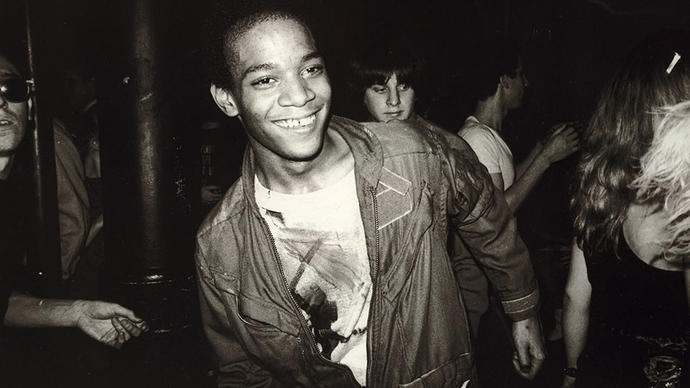The clock ticks down, the flint sparks, the fuse burns short – the tart and fleeting tang of electricity on the tongue – and then … BOOM – Boom for real…
In little more than a decade, Jean-Michel Basquiat triggered a series of intellectual and artistic explosions that reconfigured many of the creative spheres that he touched. Ripping through the late seventies and eighties his prolific and thrilling output eviscerated orthodoxy, fusing the esoteric and the conventional. He sent waves of creative innovation accelerating across traditional culture until once caste-iron categories dissolved, until his own imagination detonated in a cataclysmic paroxysm that looked backward with such ferocity that it became the future. And Basquiat left behind a cultural arena that was transformed by his brief, but brilliant presence.
He sent waves of creative innovation accelerating across traditional culture
Although he died at 27, in his short life Basquiat made a telling contribution to the cultural world, helping to normalise a particular kind of challenge to the intellectual status quo. Graffiti artist, painter, poet, DJ, philosopher, musician – Basquiat took on creative disciplines with a sure-footed mastery and left each altered. Ultimately however, they were fodder to further his greater project of dissecting the way that we perceive, categorise and give value.
Whilst recuperating after being hit by a car, his mother bought the young Basquiat a copy of Gray’s Anatomy. This Victorian exploration of the mechanics of the human body left him obsessed with ideas of dissection and reconfiguration. Throughout his career he nurtured a forensic interest in forcing us to think about how we might pull apart and remake intellectual disciplines. He looked at history as a cadaver that could be deconstructed and reanimated to suit us. Searching beyond traditional western sources of artistic inspiration, Basquiat found an alternative plane upon which to build his art, borrowing and refashioning punk, rap, ancient Egyptian history and traditional African art. From this other world he conjured a magnificent theatre of alternate possibilities, simultaneously beautiful and shocking, both thrillingly nascent and yet ancient. It beguiled with its flamboyant brilliance and stunned with its difference. This was perhaps his Grand Project, the forced re-evaluation of worth, the reconsideration of the things that we might value and deem worthy of serious consideration.
Basquiat took on creative disciplines with a sure-footed mastery and left each altered
Basquiat understood value – he escaped homelessness to become an internationally acclaimed artist in a handful of years. Perhaps driven by memories of his difficult childhood, by a hope that those early years would not define his adult life, he approached his career with a pathological application. Blessed with a defining talent he rapidly found success, while the residual pain of childhood lingered as an important catalyst for his practice. He understood the tension between his race and his gift, he knew what his talent meant, what his Blackness, his Haitian, his Puerto Rican and once African ancestry could connote to the art-world, and how this ethnicity could be used to limit his progress – but he also knew how he might deploy his identity for optimum impact. These gifts made him attractive to many of the most interesting figures of the time, collaborating with Warhol, Bowie, Grand Master Flash and Blondie, amongst many others.
During his early years of success, Basquiat’s volcanic talent was more than a counterbalance to his demons, but those anxieties intensified until ultimately, like many of his contemporaries, he was consumed by his own ghosts. Whilst there have been other artists who have reconfigured the creative metric of their time, few did so with the explosive style of Jean-Michel Basquiat.’




